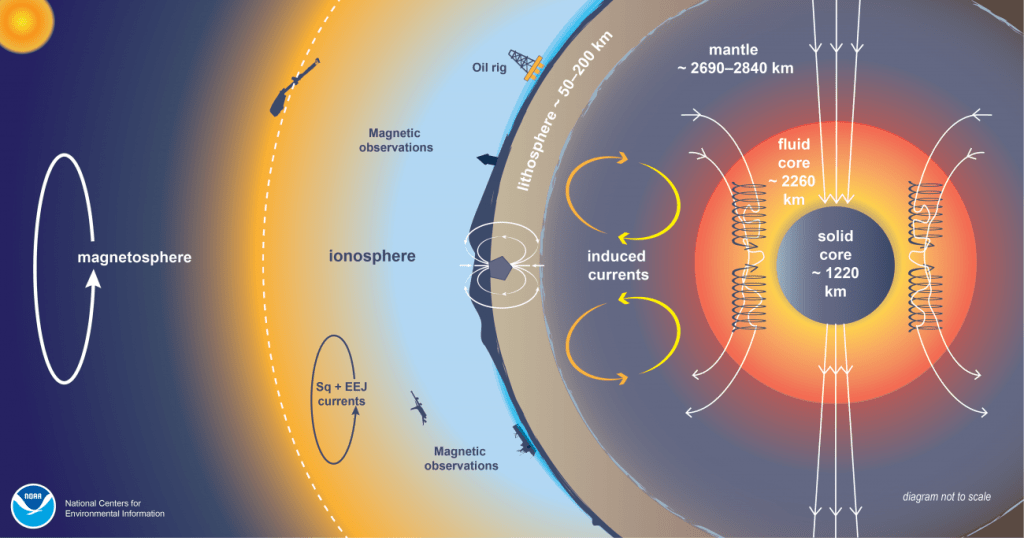Introduction To Earth’s Magnetic North Pole |
| The Earth’s magnetic north pole has captivated scientists and explorers for centuries due to its complex and dynamic nature. Unlike the geographic North Pole, which remains at a fixed point on the Earth’s surface, the magnetic north pole is not stationary. It wanders due to changes in the Earth’s magnetic field, a phenomenon driven by the flow of molten iron within our planet’s outer core. |
| This core generates electric currents, which in turn produce the magnetic field essential for navigation and animals’ migratory patterns. |
| Understanding the magnetic north pole is crucial for various technologies including GPS systems, aviation, and maritime navigation, all of which require accurate magnetic readings to function effectively. Moreover, the magnetic north plays a vital role in shielding the Earth from solar winds and cosmic radiation, impacting space weather and satellite operations. Historically, the magnetic pole has shifted, but recent studies indicate an increased rate of movement, notably toward Russia. |
| This unprecedented speed of movement sparks questions about the inner workings of our planet’s core and its impact on advanced technologies that rely heavily on magnetic information. As scientists delve deeper into understanding these shifts, it emphasizes the need to continuously monitor and adapt to changes in the Earth’s magnetic field to ensure the accuracy of navigational systems and safety protocols globally. |
Historical Movement Of The Magnetic North Pole |
| The Earth’s magnetic north pole has not been a fixed point throughout history; instead, it has demonstrated a dynamic journey across the globe. This phenomenon is primarily caused by the turbulent motion of molten iron and other metals within the Earth’s outer core, generating complex and shifting magnetic fields. Historical records and scientific measurements over the past few centuries reveal that the magnetic north pole has been steadily migrating, with its course significantly accelerating in recent decades. |
| Originally located in Canada, the pole has traversed the Arctic in an erratic pattern influenced by geophysical processes beneath the Earth’s surface. This migration has captured the attention of scientists due to its implications for navigation and communication systems that rely on magnetic north as a reference point. |
| In the mid-19th century, scientists endeavored to chart the magnetic north pole’s slow but steady progression. However, the pole’s drift notably quickened in the late 20th century, moving at speeds of nearly 55 kilometers per year around the 2000s towards Russia. This rapid movement has prompted technicians to frequently update navigation systems used by civilian and military operations worldwide. As the pole continues its journey across the Arctic, understanding its underlying geophysical mechanics remains crucial, not only for improving navigation accuracy but also for gaining deeper insights into the dynamic processes occurring within the Earth’s core. |
The Science Behind Magnetic Pole Shifts |
| The Earth’s magnetic field is primarily generated by the movement of molten iron and other metals in its outer core, a process known as the geodynamo. As the liquid metals circulate due to the Earth’s rotation and convection currents, they produce electric currents which in turn generate the magnetic field. This complex system is inherently unstable and subject to changes over time. |
| Magnetic pole shifts, or geomagnetic reversals, occur when the positions of magnetic north and south switch places. While the complete flips take thousands of years to occur and happen at irregular intervals, smaller shifts, like the current migration of the magnetic north pole, can happen more rapidly. |
| The current movement of the magnetic north pole towards Russia is part of these ongoing fluctuations. Such shifts are influenced by changes in the flow patterns of the molten iron in the outer core, which can alter the magnetic field’s strength and orientation. These variations in fluid movement can result from differences in temperature, pressure, and composition within the core. As these dynamic processes continue, they cause the magnetic field to constantly change, leading to the observed drift of the magnetic poles. |
| Although these changes can have significant consequences for navigation systems and some technologies, they are a natural part of the Earth’s geophysical processes. |
Current Trends: Magnetic North’s Shift Toward Russia |
| The Earth’s magnetic north pole has been slowly shifting across the Canadian Arctic towards Russia. This movement is not a sudden phenomenon but a continuation of a trend that has been observed for over a century. However, recent observations have indicated that the pace at which the magnetic north pole is moving has accelerated significantly, reaching speeds of up to 55 kilometers per year. |
| This shifting is part of the natural changes in the Earth’s magnetic field, which are influenced by complex processes taking place in the planet’s outer core, primarily composed of liquid iron and nickel. These changes can influence navigational systems that rely on magnetic north for compass readings, demanding regular updates to global navigation systems, including those used in smartphones, airplanes, and ships. |
| The current trend has implications for navigation, particularly in high latitude regions, where geolocational accuracy becomes crucial. Scientists are closely monitoring the pole’s journey to better predict future movements and to update models like the World Magnetic Model, which is crucial for navigation systems around the world. While it is unlikely that the moving magnetic north will lead to immediate catastrophic effects, it poses significant challenges and highlights the dynamic nature of our planet’s interior processes. |
| The ongoing shift also serves as a reminder of the geophysical dynamism that continually reshapes not just the Earth’s surface, but its magnetic environment as well. |
Implications For Navigation And Technology |
| The migration of Earth’s magnetic north pole towards Russia bears significant implications for navigation and technology. Magnetic north has been drifting steadily at an increased pace, prompting a necessity to frequently update navigation systems. One primary impact of this shift is on compasses, both traditional and those integrated into modern technology. As the magnetic pole moves, compass readings become less accurate unless they are recalibrated with the updated location of magnetic north. |
| For adventurers and navigators relying on such tools, the inaccuracy could lead to misdirection unless adjustments are made, which is particularly critical in high-latitude regions. |
| Furthermore, the aviation industry is directly affected, as it relies heavily on magnetic bearings for navigation. Airports often have to rename runways, which are titled based on their magnetic azimuth, to reflect these changes. Regular updates to aeronautical charts and systems are essential to ensure safety and operational accuracy. |
| Advanced technologies such as smartphones, GPS devices, and other electronic systems that incorporate magnetic sensors must also be updated to align calculations with the current magnetic north shifts. While GPS relies primarily on satellites, many devices use magnetic north for orientation purposes. An incorrect alignment could potentially affect their functionality, emphasizing the need for ongoing updates and adaptations in both consumer and professional navigation systems. |
Future Projections And Scientific Research |
| The movement of Earth’s magnetic north pole towards Russia has piqued the interest of scientists worldwide, sparking numerous studies and projections about its future trajectory and implications. As the pole continues its swift journey from the Canadian Arctic towards Siberia, researchers are keenly focused on understanding the underlying processes driving this shift. The magnetic north pole’s movement is primarily attributed to the dynamic flows of molten iron within the Earth’s outer core, and as these flows evolve, so too will the pole’s motion. |
| To better understand future projections, scientists are utilizing sophisticated satellite systems and geomagnetic monitoring stations globally to track the pole’s path. These technologies allow researchers to create more accurate models predicting the pole’s future location. Understanding this movement is crucial, as it has wide-reaching implications for navigation systems that rely on magnetic north, such as those used by aircraft and ships. |
| Additionally, the continued study of the magnetic pole shift provides valuable insights into the Earth’s geomagnetic field, which plays a critical role in shielding our planet from harmful solar radiation. As research continues, scientists are hopeful that they can better predict not only the pole’s future pathway but also potential impacts on Earth’s protective magnetic field. Enhanced understanding will aid in developing strategies to mitigate any adverse effects on human technology and the environment. |
References
| [0] | “Earth’s North Magnetic Pole Moved — Why That Matters for Navigation – Business Insider.” businessinsider.com, 06. Feb. 2019, https://www.businessinsider.com/earths-magnetic-north-pole-moved-navigation-2019-2. Accessed 21. Nov 2024. |
| [1] | “Earth’s north magnetic pole has officially shifted.” nypost.com, 05. Feb. 2019, https://nypost.com/2019/02/05/earths-north-magnetic-pole-has-officially-shifted/. Accessed 21. Nov 2024. |
| [2] | “Navigating the Difference: True North vs. Magnetic North – HiiKER.” blog.hiiker.app, 08. Sept. 2023, https://blog.hiiker.app/2023/09/08/navigating-the-difference-true-north-vs-magnetic-north/. Accessed 21. Nov 2024. |
| [3] | “Earth’s Magnetic Field: Origin, Structure, and Impact on Humanity – Earth.com.” earth.com, 04. Oct. 2024, https://www.earth.com/earthpedia-articles/earths-magnetic-field-origin-structure-and-impact-on-humanity/. Accessed 21. Nov 2024. |
| [4] | “The magnetic North Pole is still moving toward Russia, but has slowed its pace – ArcticToday.” arctictoday.com, 26. Dec. 2019, https://www.arctictoday.com/the-magnetic-north-pole-is-still-moving-toward-russia-but-has-slowed-its-pace/. Accessed 21. Nov 2024. |
| [5] | “NRIPage | Articles | Earth’s Magnetic North Pole Shifting Rapidly Towards Russia, Affecting Navigation Systems.” nripage.com, 20. Nov. 2024, https://www.nripage.com/articles/science/2024/11/20/earths-magnetic-north-pole-shifting-rapidly-towards-russia-affecting-navigation-systems. Accessed 21. Nov 2024. |
| [6] | “The Magnetic North Pole is moving closer to Russia? Scientists puzzled – The Jerusalem Post.” jpost.com, 18. Nov. 2024, https://www.jpost.com/science/science-around-the-world/article-829592. Accessed 21. Nov 2024. |
| [7] | “Magnetic North Pole’s Unusual Shift Stuns Scientists as it Moves Towards Russia – World News – Thailand News, Travel & Forum – ASEAN NOW.” aseannow.com, 18. Nov. 2024, https://aseannow.com/topic/1343781-magnetic-north-poles-unusual-shift-stuns-scientists-as-it-moves-towards-russia/. Accessed 21. Nov 2024. |
| [8] | “North Pole’s Magnetic Shift Toward Russia Raises Concerns Over Smartphone Navigation Accuracy – 24/7 News.” 247news.com.pk, 19. Nov. 2024, https://247news.com.pk/?p=14716. Accessed 21. Nov 2024. |
| [9] | “US Geologist REVEALS How Fast-Shifting North Magnetic Pole Will Affect Humanity – 12.02.2019, Sputnik International.” sputnikglobe.com, 12. Feb. 2019, https://sputnikglobe.com/20190212/geologist-comments-on-north-magnetic-pole-motion-1072344917.html. Accessed 21. Nov 2024. |
| [10] | “Magnetic north moved 50 miles last year (let’s map it!) – Graphically Speaking.” blogs.sas.com, 31. Jan. 2020, https://blogs.sas.com/content/graphicallyspeaking/2020/01/31/magnetic-north-moved-50-miles-last-year-lets-map-it/. Accessed 21. Nov 2024. |
| [11] | “What is driving the movement of Earth’s magnetic north? – Earth.com.” earth.com, 26. Nov. 2019, https://www.earth.com/news/earths-magnetic-north-movement/. Accessed 21. Nov 2024. |
| [12] | “What Happens if the Magnetic North Pole Keeps Rushing Toward Siberia?.” vice.com, 09. Aug. 2024, https://www.vice.com/en/article/what-happens-if-the-magnetic-north-pole-keeps-rushing-toward-siberia/. Accessed 21. Nov 2024. |
| [13] | “Scientists explain magnetic pole’s wanderings.” bbc.com, 05. May 2020, https://www.bbc.com/news/science-environment-52550973. Accessed 21. Nov 2024. |
| [14] | “Why is Earth’s Magnetic North Pole Drifting So Rapidly? – Geology In.” geologyin.com, 02. July 2024, https://www.geologyin.com/2024/07/earth-magnetic-north-pole-drifting.html. Accessed 21. Nov 2024. |
| [15] | “Interesting Things at the Top of World – Magnetic North, Variance, etc..” asa.com, 31. Oct. 2020, https://asa.com/news/2020/10/31/interesting-things-at-the-top-of-world/. Accessed 21. Nov 2024. |
| [16] | “Magnetic Poles Shifting: Understanding Earth’s Changing Magnetism.” suchscience.net, 13. Feb. 2024, https://suchscience.net/magnetic-poles-shifting/. Accessed 21. Nov 2024. |
| [17] | “Earth’s North Pole shifting faster: Is a Pole-flip imminent? How will it impact us? – Hindustan Times.” hindustantimes.com, 15. May 2024, https://www.hindustantimes.com/science/earths-north-pole-shifting-faster-is-a-pole-flip-imminent-how-will-it-impact-us-101715780759793.html. Accessed 21. Nov 2024. |
| [18] | “Alarming NOAA data, Rapid Pole Shift.” modernsurvivalblog.com, 24. Sept. 2023, https://modernsurvivalblog.com/natural-disaster/alarming-noaa-data-rapid-pole-shift/. Accessed 21. Nov 2024. |
| [19] | “Magnetic North Pole Shifts in ‘Unprecedented’ Ways Never Seen Before by Scientists.” dailygalaxy.com, 19. Nov. 2024, https://dailygalaxy.com/2024/11/magnetic-north-pole-shifts-in-an-unprecedented-ways-never-seen-before-by-scientists/. Accessed 21. Nov 2024. |
| [20] | “ESA – Earth from Space: Earth’s North Magnetic Pole.” esa.int, 19. Dec. 2008, https://www.esa.int/Applications/Observing_the_Earth/Earth_from_Space_Earth_s_North_Magnetic_Pole. Accessed 21. Nov 2024. |
| [21] | “Earth’s Magnetic North Pole Has Officially Moved.” forbes.com, 05. Feb. 2019, https://www.forbes.com/sites/trevornace/2019/02/05/earths-magnetic-north-pole-has-officially-moved/. Accessed 21. Nov 2024. |
| [22] | “RSTV IAS UPSC – Shifting Magnetic North Pole.” iasbaba.com, 12. Mar. 2019, https://iasbaba.com/2019/03/rstv-ias-upsc-shifting-magnetic-north-pole/. Accessed 21. Nov 2024. |
| [23] | “Scientists left baffled as they make major Magnetic North Pole discovery.” gbnews.com, 16. Nov. 2024, https://www.gbnews.com/science/scientists-left-baffled-as-they-make-major-magnetic-north-pole-discovery. Accessed 21. Nov 2024. |
| [24] | “Earth’s fast-moving magnetic north pole is messing with navigation.” sg.news.yahoo.com, 04. Feb. 2019, https://sg.news.yahoo.com/2019-02-04-magnetic-north-pole-movement-affects-navigation.html. Accessed 21. Nov 2024. |
| [25] | “Earth’s magnetic North Pole is shifting toward Russia. What does that mean?.” yahoo.com, 19. Nov. 2024, https://www.yahoo.com/news/earths-magnetic-north-pole-shifting-234637155.html. Accessed 21. Nov 2024. |
| [26] | “Notes on What Causes Geomagnetic Reversal?.” unacademy.com, 26. Apr. 2022, https://unacademy.com/content/neet-ug/study-material/physics/what-causes-geomagnetic-reversal/. Accessed 21. Nov 2024. |
| [27] | “Earth’s magnetic north pole is hurtling toward Russia.” wral.com, 05. Feb. 2019, https://www.wral.com/story/earth-s-magnetic-north-pole-is-hurtling-toward-russia/18170343/. Accessed 21. Nov 2024. |
| [28] | “Compass – Wikipedia.” en.wikipedia.org, 21. Oct. 2024, https://en.wikipedia.org/wiki/Compass. Accessed 21. Nov 2024. |
| [29] | “Geomagnetic Reversal, Magnetic Declination & Inclination (Dip) – PMF IAS.” pmfias.com, 27. Dec. 2019, https://www.pmfias.com/geomagnetic-reversal-magnetic-declination-magnetic-inclination/. Accessed 21. Nov 2024. |
| [30] | “The Earth’s Magnetic ‘North’ Pole Has Officially Shifted | Evolving Science.” evolving-science.com, 16. Feb. 2019, https://www.evolving-science.com/environment/north-pole-shift-00927. Accessed 21. Nov 2024. |
| [31] | “Why Is Earth’s Magnetic North Pole Moving Eastwards Across The Globe? | IFLScience.” iflscience.com, 19. Nov. 2024, https://www.iflscience.com/why-is-earths-magnetic-north-pole-moving-eastwards-across-the-globe-76827. Accessed 21. Nov 2024. |
| [32] | “North magnetic pole – Wikipedia.” en.wikipedia.org, 02. Nov. 2024, https://en.wikipedia.org/wiki/North_magnetic_pole. Accessed 21. Nov 2024. |
| [33] | “The magnetic north pole is messing with your smartphone’s mapping apps | MIT Technology Review.” technologyreview.com, 15. Jan. 2019, https://www.technologyreview.com/2019/01/15/137831/the-magnetic-north-pole-is-messing-with-your-smartphones-mapping-apps/. Accessed 21. Nov 2024. |
| [34] | “NASA Researchers Track Slowly Splitting ‘Dent’ in Earth’s Magnetic Field – NASA.” nasa.gov, 29. Sept. 2023, https://www.nasa.gov/missions/icon/nasa-researchers-track-slowly-splitting-dent-in-earths-magnetic-field/. Accessed 21. Nov 2024. |
| [35] | “Earth’s North Magnetic Pole Is Heading Towards Siberia – Geology In.” geologyin.com, 09. Sept. 2024, https://www.geologyin.com/2022/12/earths-north-magnetic-pole-is-heading.html. Accessed 21. Nov 2024. |
| [36] | “North Magnetic Pole wandering away.” physicsforums.com, 15. Jan. 2019, https://www.physicsforums.com/threads/north-magnetic-pole-wandering-away.964124/. Accessed 21. Nov 2024. |
| [37] | “Earth’s magnetic field is changing rapidly, could the poles reverse soon?.” yourweather.co.uk, 08. Dec. 2023, https://www.yourweather.co.uk/news/science/earth-s-magnetic-field-is-changing-rapidly-could-the-poles-reverse-soon.html. Accessed 21. Nov 2024. |
| [38] | “Earth’s Magnetic North Pole Is On The Move – The Pinnacle Gazette.” evrimagaci.org, 21. Nov. 2024, https://evrimagaci.org/tpg/earths-magnetic-north-pole-is-on-the-move-64537?srsltid=AfmBOor9GB1Mro8BtZXyapNnMt5o_iM2AFbAgVdN8lKUHdeLNvGyowqw. Accessed 21. Nov 2024. |
| [39] | “Earth’s Magnetic North Pole Moving Closer To Russia. Here’s What It Means.” ndtv.com, 20. Nov. 2024, https://www.ndtv.com/science/earths-magnetic-north-pole-moving-closer-to-russia-heres-what-it-means-7061695. Accessed 21. Nov 2024. |





